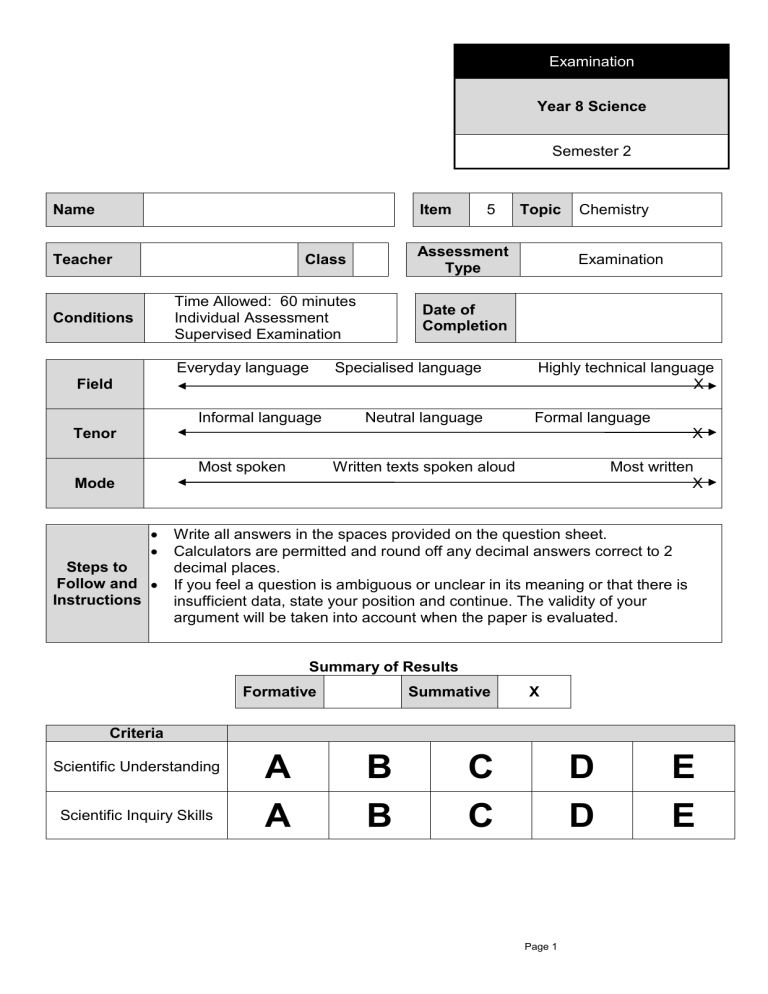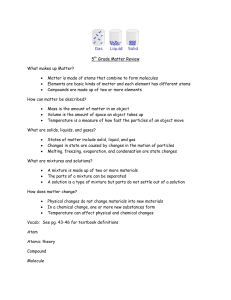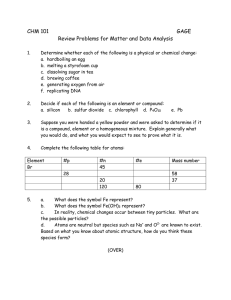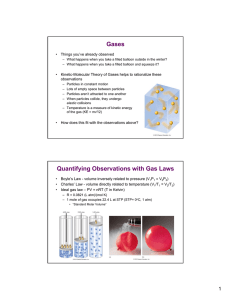
Examination Year 8 Science Semester 2 Name Item Teacher Time Allowed: 60 minutes Individual Assessment Supervised Examination Everyday language Chemistry Examination Date of Completion Specialised language Field Informal language Topic Assessment Type Class Conditions 5 Neutral language Highly technical language X Formal language Tenor X Most spoken Written texts spoken aloud Most written X Mode Steps to Follow and Instructions Write all answers in the spaces provided on the question sheet. Calculators are permitted and round off any decimal answers correct to 2 decimal places. If you feel a question is ambiguous or unclear in its meaning or that there is insufficient data, state your position and continue. The validity of your argument will be taken into account when the paper is evaluated. Summary of Results Formative Summative X Criteria Scientific Understanding Scientific Inquiry Skills A A B B C C D D Page 1 E E Years 8 learning area standards descriptors: Science Scientific Concepts Assessed Understanding Skills Properties of matter and the particle theory Physical and chemical change Density Elements and the periodic table Compounds and mixtures Chemical equations A B C D E Statements of scientific information and science knowledge. Statements of isolated information. The folio of student work has the following characteristics: Comprehensive description and explanation of scientific information, concepts and relationships. Q10 Use of science knowledge to generate solutions and justified explanations in a range of situations, including some that are complex and unfamiliar. Significant description and explanation of scientific information, concepts and relationships. Q9a Description and identification of scientific information and concepts. Q1-5, Q6, Q7 Use of science knowledge to generate solutions and informed explanations in complex familiar situations. Use of science knowledge to generate solutions and explanations in simple familiar situations. Use of science knowledge to generate partial solutions and explanations. Q9b Q8 The folio of student work has the following characteristics: Analysis of trends in data to identify and explain relationships between variables to draw justified conclusions. Q15b, Q16b Analysis of trends in data to identify and describe relationships between variables to draw conclusions consistent with evidence. Q13b, Q14 Page 2 Analysis of trends in data to identify relationships between variables. Q11, Q12, Q13a, Q15a, Q16a Statements about trends and inconsistencies in data and information. Statements about data. Scientific Understanding Question 1* Identify in which state of matter the forces holding particles together are the strongest. a) Gas b) Solid c) Liquid d) Plasma Question 2* Identify which of the following is a pure substance. a) A substance that has tiny particles suspended in solution. b) A substance that contains particles that are all the same type. c) A substance that has particles dissolved throughout the solution. d) A substance that contains several different types of particles mixed together. Question 3* A gold miner shakes a mixture of mud and water in a gold pan. Identify the reason why he looks for the gold at the bottom of the pan. a) Gold is hard to find because it can ‘hide’. b) Gold is repelled by other earth’s minerals. c) Gold is very dense and sinks to the bottom of the pan. d) Gold dissolves in water and is carried to the bottom of the pan. Question 4* Identify which scenario indicates that a chemical reaction has occurred. a) Salt dissolves in water to form a solution. b) A block of chocolate left in a hot car melts. c) A concrete path cracks due to intense heat. d) A glow stick is snapped, shaken slightly and then begins to glow. Question 5* Read the following statements about elements and compounds and identify which statement is correct. a) Elements are unable to exist as molecules. b) Metallic elements tend to appear dull and are used as insulators. c) Elements are substances that are made up of several different atoms. d) Water is a molecular compound (H20) containing the elements hydrogen and oxygen. Page 3 Question 6* Identify the reactants in the following chemical equation by circling your response: Nitric oxide + Ozone Nitrogen dioxide + Oxygen gas Question 7* Carbon dioxide molecules are naturally found in our atmosphere. In the table below, identify the name of each type of atom, the number of each type of atom, and the total number of atoms present in a carbon dioxide molecule. CO2 Name of Atoms How many of each type of atom Total Number of atoms Question 8**. Amy is making pancakes for breakfast using the following recipe she found online: PANCAKE RECIPE 1. Mix flour and sugar in a large bowl. 2. In a small jug add sodium bicarbonate to buttermilk and allow to stand until frothy. 3. Crack one egg into the small jug, beat gently. 4. Add wet ingredients into the dry ingredients and mix. 5. Place tablespoons of the mixture into a heated frypan and flip when bubbles appear on the outside of the pancake. Identify and explain one chemical change which occurs during the process of making pancakes for breakfast. _____________________________________________________________________________________ _____________________________________________________________________________________ _____________________________________________________________________________________ _____________________________________________________________________________________ _____________________________________________________________________________________ _____________________________________________________________________________________ _____________________________________________________________________________________ _____________________________________________________________________________________ ____________________________________________________________________________________ Page 4 Question 9 An unidentified element is found by two astronauts on the planet Mars. The astronauts conducted several experiments on the element and the observations they made are summarised in the table below. Experiment Observation Heated by the flame of a Bunsen burner Glowed red Ability to be cut with a knife Easily done Reflective ability Able to reflect light, appears shiny Based on these observations Astronaut A decides it should be classified in the periodic table as a metal. However, Astronaut B thinks it should be classified as a non-metal. a)** Evaluate what supporting evidence each argument has. b)*** Give a justified explanation of what additional evidence would be required to confirm the elements classification as a metal or non-metal. Page 5 Question 10*** A teacher was trying to find out what a group of students knew about heating, cooling, and the particle model. She put a balloon over the top of a plastic bottle as shown in the diagram (Fig. 1). She asked the students to write down what would happen, and why, if she put the bottle in a large beaker of hot water. The following is what three of the students wrote: Megan wrote: ‘The balloon will get bigger that is because the air particles get bigger when they are heated.’ Bill wrote: ‘The balloon will get bigger that is because the air particles have more energy and move faster, so they will move into the balloon and hit its wall with strong force.’ Susan wrote: ‘The balloon will get bigger that is because all of the particles in the bottle will move into the balloon.’ Fig. 1 Identify which student’s response is correct and justify your choice using your knowledge of the particle theory of matter. Page 6 Scientific Inquiry Question 11*. Using the above periodic table identify which element is represented by the symbol Cl. a) Calcium b) Chlorine c) Magnesium d) Nitrogen Question 12* Using the above periodic table identify the symbol used to represent sodium. a) Cl b) Na c) S d) Si Page 7 Question 13 The diagram below shows the arrangement of particles in four different substances (A, B, C, and D). a)* Identify each of these substances as either an element, compound, or mixture and complete the table below. Element, Compound, or Mixture? A B C D b)** Using your knowledge of elements, molecules and compounds, describe 2 pieces of evidence used to reach your conclusion for SUBSTANCE B. Evidence 1 Evidence 2 Page 8 Question 14** The table below shows the melting points and boiling points of four imaginary elements. Complete the table below, stating whether the substance is a solid, a liquid or a gas in a room that is 20°C. Element Melting Point (°C) Boiling Point (°C) Xyggium -189 -186 Zrttord YYrtesium Caetriol 714 -39 44 1640 357 280 State at 20°C Question 15 Table 1 below shows the mass of various liquids, each with a volume of 100mL. Table 1. Type of Liquid Mass of 100mL of Liquid (grams) Petrol Fresh Water Blood Glycerine 70 100 105 126 The density of any substance can be determined by using the formula: mass (g) Density (g/mL) = volume (mL) a)* Calculate the density, in g/ mL, for the two liquids listed below. Blood Glycerine Page 9 b)*** Mercury is a liquid with a density of 140 grams per 100 mL. Using the information in Table 1 identify substance/s that would sink in water but would float on mercury. Justify your decision. Page 10 Question 16 When magnesium is burnt it combines with oxygen in the air to create magnesium oxide. The graph below shows the amount of reactants and products present during this chemical reaction experiment over time. Amount of Substance (mg) Line X Line Y Time a) * Identify from the graph which line represents the reactants and which line represents the products from the chemical reaction described above. Reactants: ___________________________________________ Products: ____________________________________________ b) *** Justify your decision by analysing the trends in the data to explain the relationship over time between the amount of reactants and products in a chemical reaction. ______________________________________________________________________________ ______________________________________________________________________________ ______________________________________________________________________________ ______________________________________________________________________________ ______________________________________________________________________________ ______________________________________________________________________________ ______________________________________________________________________________ ______________________________________________________________________________ ______________________________________________________________________________ ______________________________________________________________________________ ______________________________________________________________________________ ______________________________________________________________________________ Page 11 Year 8 Science – Semester 2 – Item 5 – Marking Scheme Criterion Question Standard A Standard B 1-5 6 7 Scientific Understanding 8 9a 9b 10 OVERALL 11 12 13a 13b 14 Science Inquiry 15a 15b 16a 16b OVERALL 12 Standard C Standard D Standard E







